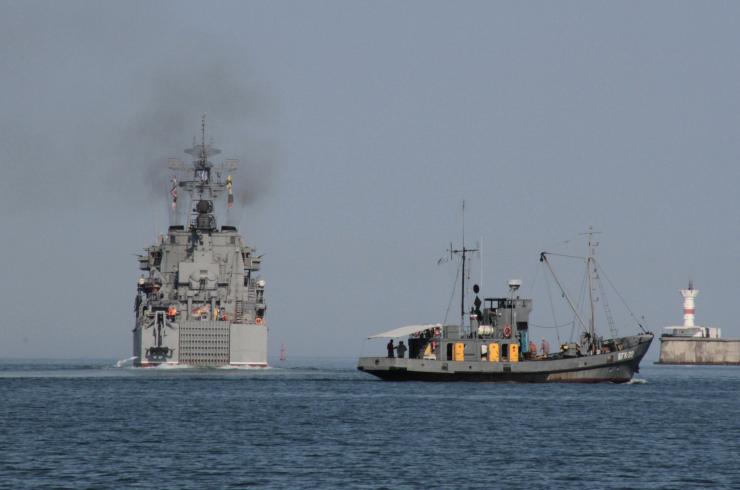
Russian, NATO Maritime Deployments Intensify off Syria
Publication: Eurasia Daily Monitor Volume: 12 Issue: 219
By:

Despite differing political agendas in Syria’s ongoing civil war, Russia and the members of the North Atlantic Treaty Organization (NATO) are now sending significant naval forces to Syria’s Mediterranean coastline. The eastern Mediterranean is becoming crowded, as ten countries, in addition to Russia and Turkey, currently have warships in the area, including the NATO member states’ nuclear aircraft carriers USS Theodore Roosevelt (CVN 71) and France’s Charles de Gaulle (Hurriyet, December 6). In all, 13 foreign warships are now deployed off the Syrian coast (Güneş Gazetisi, December 6). The surge in naval forces comes in the wake of Turkey’s November 24 shooting down of a Russian Su-24M tactical bomber jet, which violated Turkish airspace, adding to an already volatile and tense situation in this constricted sea, land and aerial space.
Turkey has declined to apologize for its actions, which has led to the deepest crisis in Russian-Turkish relations since the Cold War. Fellow NATO members are backing Turkey at present. But given that Turkey controls the Bosporus and Dardanelles, the Russian Black Sea Fleet’s sole entrance and egress to the Mediterranean, the continuing naval buildup off Syria makes the chance of confrontation, more, not less, likely.
Since the outbreak of the Syrian conflict four years ago, Russia has supported Syrian President Bashar al-Assad, drawing opprobrium in the West. Warships from the Black Sea Fleet have been the primary Russian naval component operating off Syria, most notably the Moskva anti-submarine warfare (ASW) cruiser, the flagship of the Black Sea Fleet. And more recently, vessels from Russian Baltic and Northern fleets have also been dispatched to the eastern Mediterranean (Moskovskii Komsomolets, November 25).
Symptomatic of the rising tensions produced by the naval deployments, in the aftermath of the November 24 downing of the Su-24, the Russian media reported that two Turkish submarines were shadowing the Moskva (Argument i Fakty, November 30).
For the West, the most startling naval development in the ongoing Syrian conflict came on October 7, when a Russian Caspian Flotilla frigate and three destroyers launched 26 Kalibr 3M-14T cruise missiles at 11 targets in Syria, which flew nearly 1,000 miles through first Iranian and then Iraqi airspace before hitting alleged terrorist sites in Raqqa, Aleppo and Idlib provinces (Krasnaia Zvezda, October 7). The missile used in the strikes, the Kalibr 3M-14T (NATO designation SS-N-30A), is an improved version of the Granat land-attack cruise missile, similar to the United States Navy’s Tomahawk BGM-109 (Voennoe Obozrenie, June 6, 2013).
The Syrian deployments follow on increased NATO deployments into the Black Sea since Russia’s March 2014 annexation of Crimea. Russia has repeatedly criticized this growing NATO presence there. In that context, North Atlantic Alliance warships from the Standing NATO Maritime Group One—consisting of Portugal’s F-334 NRP Francisco de Almeida frigate, Spain’s F-105 ESPS Blaz de Lezo frigate and Canada’s FFG-338 HMCS Winnipeg frigate—arrived in Istanbul, on December 6, anchoring off Sarayburnu (Today’s Zaman, December 6). And days earlier, on December 3, the USS Ross destroyer entered the Black Sea as part of NATO’s ongoing deployments there. This was the first US naval visit to the Black Sea since Turkey shot down the Russian bomber (Regnum, December 4).
That same day, symbolic of the lingering tensions between Russia and Turkey since November 24, as the Black Sea Fleet’s Tsezar’ Kunikov Ropucha-I class amphibious landing ship transited the Bosporus en route to the Mediterranean, a crewman stood on deck conspicuously brandishing a personal surface-to-air missile launcher. Turkish Foreign Minister Mevlüt Çavuşoğlu immediately condemned the incident, saying, “This is a provocation, this is a harassing passage. The Russian warplanes’ violation of our airspace and the passing of the Russian warships through the Bosporus [which bisects the 14 million person city of Istanbul] are two very different things. The passages should be made in accordance with the international agreements, whether it is a Russian ship or of another nationality, the rules have long been determined” (Anadolu Ajansi, December 6). Turkey’s Transport, Maritime Affairs and Communications Minister Binali Yildirim also criticized the incident, stating, “This is a clear provocation. Moreover, it also violates the Montreux Straits Convention” (Milliyet, December 6).
In an area where historical gestures are significant, the Tsezar’ Kunikov was the flagship of the Black Sea Fleet squadron that participated in the battle off the coast of Abkhazia during the 2008 Russia-Georgia five days’ war (RTR, August 10, 2008).
President Vladimir Putin is proud of the Russian military’s prowess in Syria. During his annual address to the Federal Assembly, on December 3, he told his audience, “The Russian Army and Navy have convincingly demonstrated their combat readiness and their increased capabilities. Modern Russian weapons have proved to be effective, and the invaluable practice of using them in combat conditions is being analyzed and will be used to further improve our weapons and military equipment” (Kremlin.ru, December 3). Given Putin’s commitment to supporting al-Assad, Turkey and the West can expect Russia’s military presence in Syria not only to continue, but also expand.
Both Russian and NATO deployments are intended to assist in achieving some form of peace in Syria. But the concentration of so many warships from countries with such differing political agendas in such a constricted space—combined with recent firm, provocative or bellicose gestures by Russia, Turkey and NATO—may lead to inadvertent confrontations that could ultimately produce the opposite effect.




